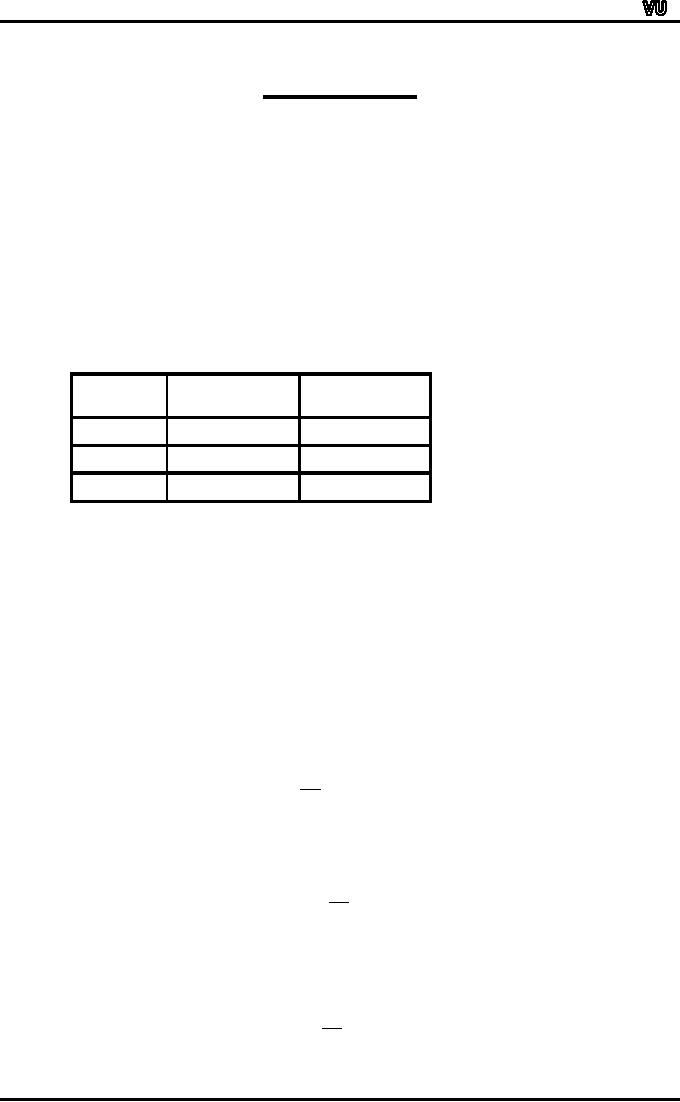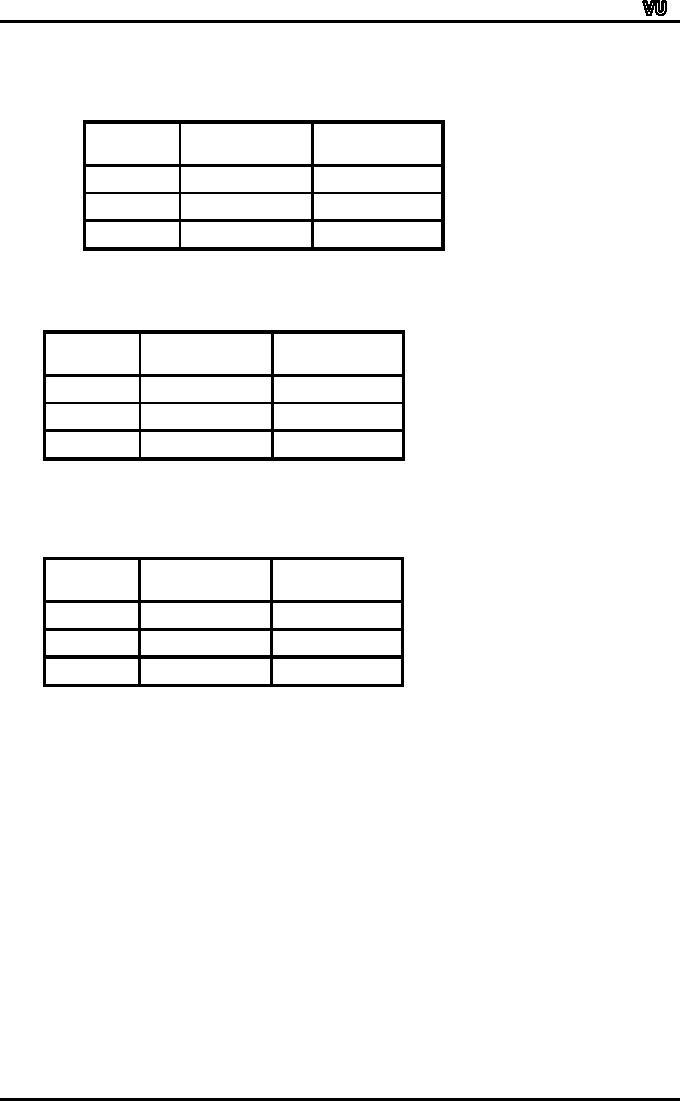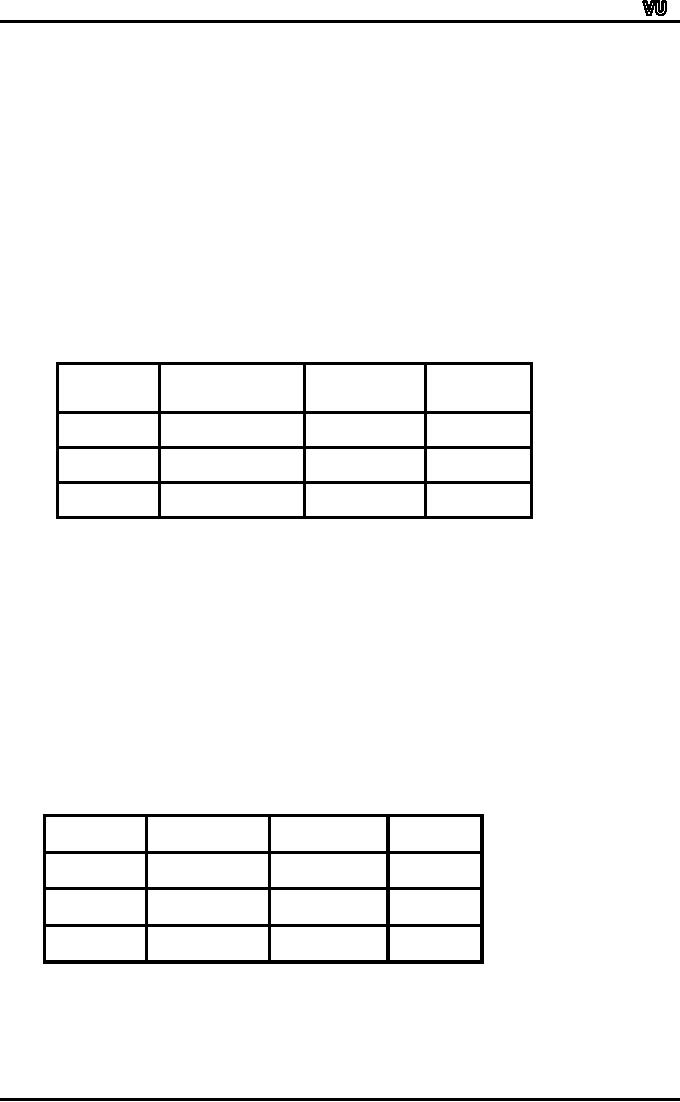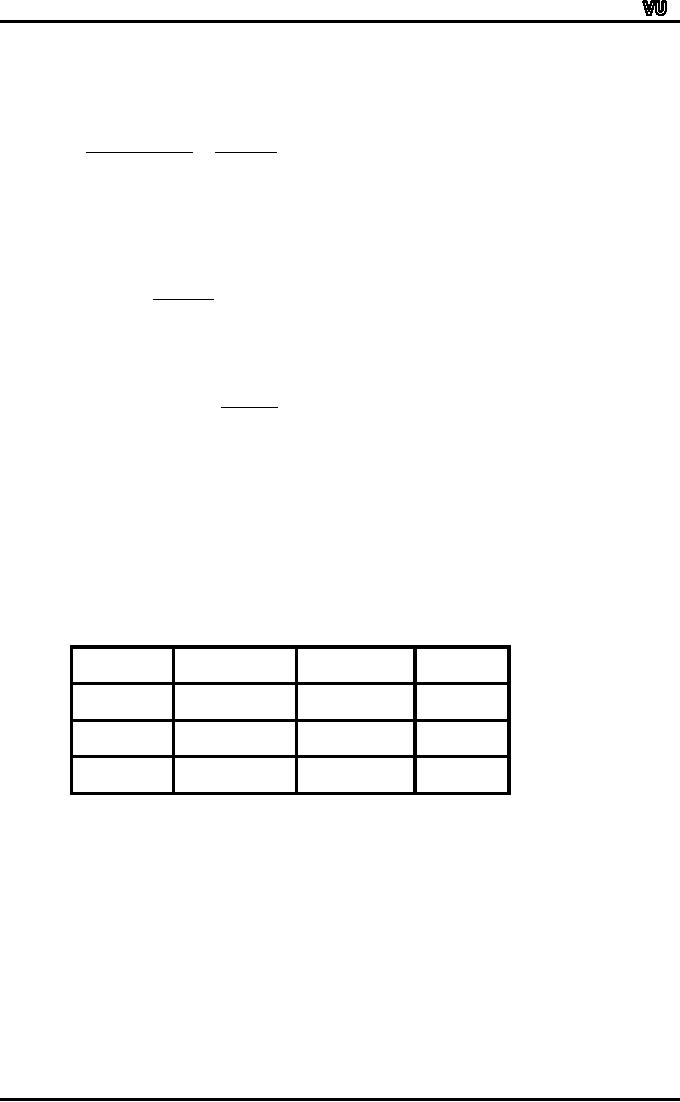 |
THE RELATIVE FREQUENCY DEFINITION OF PROBABILITY:INDEPENDENT EVENTS |
| << THE RELATIVE FREQUENCY DEFINITION OF PROBABILITY:ADDITION LAW |

MTH001
Elementary Mathematics
LECTURE #
32:
�
Independent
and Dependent Events
�
Multiplication
Theorem of Probability for
Independent Events
�
Marginal
Probability
Before
we proceed the concept of
independent versus dependent
events, let us review
the
Addition
and Multiplication Theorems of
Probability that were
discussed in the last
lecture.
To
this end, let us consider an
interesting example that
illustrates the application of
both of
these
theorems in one
problem:
EXAMPLE:
A
bag contains 10 white and 3
black balls. Another bag
contains 3 white and 5 black
balls.
Two
balls are transferred from
first bag and placed in
the second, and then
one ball is taken
from
the latter.
What
is the probability that it is a
white ball?
In
the beginning of the
experiment, we have:
Colour
of
No.
of
No.
of
Ball
Balls
in Bag A
Balls
in Bag B
White
10
3
Black
3
5
Total
13
8
Let
A represent the event that 2
balls are drawn from
the first bag and
transferred to the
second
bag. Then A can occur in
the following three mutually
exclusive ways:
A1
= 2 white balls are
transferred to the second
bag.
A2
= 1 white ball and 1 black
ball are transferred to the
second bag. ⎛13⎞
⎜
⎟.
⎜
2⎟
A3
= 2 black balls are
transferred to the second
bag.
⎝ ⎠
Then,
the total number of ways in
which 2 balls can be drawn
out of a total of 13 balls is
⎛10 ⎞
⎜
⎟.
⎜
2⎟
⎝ ⎠
And,
the total number of ways in
which 2 white balls can be
drawn out of 10 white balls
is
Thus,
the probability that two
white balls are selected
from the first bag
containing 13 balls
(in
order to transfer
to the
second bag) is
⎛10 ⎞
⎛13⎞
45
P( A1 )
= ⎜ ⎟ � ⎜ ⎟
=
⎜
2
⎟ ⎜
2
⎟
78
,
⎝ ⎠ ⎝ ⎠
Similarly,
the probability that one
white ball and one
black ball are selected
from the first
bag
containing
13 balls (in order to
transfer
to the
second bag) is
⎛10 ⎞
⎛ 3⎞
⎛13⎞
30
P( A2 )
= ⎜ ⎟ ⎜ ⎟ � ⎜ ⎟ =
,
⎜
1
⎟
⎜1
⎟ ⎜
2
⎟
78
⎝
⎠⎝ ⎠ ⎝ ⎠
And,
the probability that two
black balls are selected
from the first bag
containing 13 balls
(in
order
to transfer
to the
second bag) is
⎛
3
⎞
⎛13⎞
3
P( A3 )
= ⎜ ⎟ � ⎜ ⎟ =
.
⎜
2
⎟ ⎜
2
⎟
78
⎝ ⎠
⎝ ⎠
Page
222

MTH001
Elementary Mathematics
AFTER
having transferred 2 balls
from the first bag,
the second bag
contains
i)
5 white
and 5 black balls (if 2
white balls are
transferred)
Colour
of
No.
of
No.
of
Ball
Balls
in Bag A
Balls
in Bag B
White
10
2 = 8
3+2=5
Black
3
5
Total
13
2 = 11
8
+ 2 = 10
Hence:
P(W/A1) = 5/10
ii)
4
white and 6 black
balls
(if
1 white and 1 black ball
are transferred)
Colour
of
No.
of
No.
of
Ball
Balls
in Bag A
Balls
in Bag B
White
10
1 = 7
3+1=4
Black
31=2
5+1=4
Total
13
2 = 11
8
+ 2 = 10
Hence:
P(W/A2) = 4/10
iii)
3
white and 7 black
balls
(if
2 black balls are
transferred)
Colour
of
No.
of
No.
of
Ball
Balls
in Bag A
Balls
in Bag B
White
10
3
Black
32=1
5+2=7
Total
13
2 = 11
8
+ 2 = 10
Hence:
P(W/A3) = 3/10
Let
W represent the event that
the WHITE ball is drawn
from the second bag
after
having
transferred 2 balls from the
first bag.
Then
P(W) = P(A1∩W) +
P(A2∩W) +
P(A3∩W)
Now
P(A1 ∩
W) =
P(A1)P(W/A1)
=
45/78 �
5/10
=
15/52
P(A2
∩
W) =
P(A2)P(W/A2)
=
30/78 �
4/10
=
2/13,
and
P(A3
∩
W) =
P(A3)P(W/A3)
=
3/78 �
3/10
=
3/260.
Hence
the required probability
is
P(W)
=
P(A1∩W) +
P(A2∩W) +
P(A3∩W)
Page
223

MTH001
Elementary Mathematics
=
15/52 + 2/13 + 3/260
=
59/130
=
0.45
Next,
we discuss the concept of
INDEPENDENT EVENTS:
INDEPENDENT
EVENTS:
Two
events A and B in the same
sample space S, are defined
to be independent (or
statistically
independent) if the probability
that one event occurs, is
not affected by
whether
the
other event has or has
not occurred, that is
P(A/B)
= P(A) and P(B/A) =
P(B).
It
then follows that two
events A and B are
independent if and only
if
P(A
∩
B) =
P(A) P(B)
and
this is known as the
special
case of the
Multiplication Theorem of
Probability.
RATIONALE:
According
to the multiplication theorem of
probability, we have:
P(A
∩
B) =
P(A) . P(B/A)
Putting
P(B/A) = P(B), we
obtain
P(A
∩
B) =
P(A) P(B)
The
events A and B are defined
to be DEPENDENT
if
P(A∩B) ≠
P(A)
�
P(B).
This
means that the occurrence of
one of the events in some
way affects the probability
of
the
occurrence of the other
event. Speaking of independent
events, it is to be emphasized
that
two events that are
independent, can NEVER be
mutually exclusive.
EXAMPLE:
Two
fair dice, one red
and one green, are
thrown.
Let
A denote the event that
the red die shows an
even number and let B
denote the event
that
the green die shows a 5 or a
6. Show that the events A
and B are
independent.
The
sample space S is represented by
the following 36
outcomes:
S
= {(1, 1), (1, 2),
(1, 3), (1, 5),
(1, 6);
(2,
1), (2, 2), (2,
3), (2, 5), (2,
6);
(3,
1), (3, 2), (3,
3), (3, 5), (3,
6);
(4,
1), (4, 2), (4,
3), (4, 5), (4,
6);
(5,
1), (5, 2), (5,
3), (5, 5), (5,
6);
(6,
1), (6, 2), (6,
3), (6, 5), (6, 6)
}
Since
A
represents the event that
red die shows an even
number, and B represents the
event that
green
die shows a 5 or a 6,
Therefore
A ∩
B
represents the event that
red die shows an even
number and green
die
shows
a 5 or a 6.
Since
A represents the event that
red die shows an even
number, hence P(A) =
3/6.
Similarly,
since B represents the event
that green die shows a 5 or
a 6, hence P(B) =
2/6.
Now,
in order to compute the
probability of the joint
event A ∩
B,
the first point to
note
is that, in all, there are
36 possible outcomes when we
throw the two dice
together, i.e.
S
= {(1, 1), (1, 2),
(1, 3), (1, 5),
(1, 6);
(2,
1), (2, 2), (2,
3), (2, 5), (2,
6);
(3,
1), (3, 2), (3,
3), (3, 5), (3,
6);
(4,
1), (4, 2), (4,
3), (4, 5), (4,
6);
(5,
1), (5, 2), (5,
3), (5, 5), (5,
6);
(6,
1), (6, 2), (6,
3), (6, 5), (6, 6)
}
The
joint event A ∩
B
contains only 6 outcomes out
of the 36 possible
outcomes.
These
are (2, 5), (4,
5), (6, 5), (2,
6), (4, 6), and
(6, 6).
P(A
∩
B) =
6/36.
and
Now
P(A)
P(B)
Page
224

MTH001
Elementary Mathematics
=
3/6 �
2/6
=
6/36
=
P(A ∩
B).
Therefore
the events A and B are
independent.
Let
us now go back to the
example pertaining to live
births and stillbirths that
we
considered
in the last lecture, and
try to determine whether or
not sex of the baby
and
nature
of birth are
independent.
EXAMPLE
:
Table-1
below shows the numbers of
births in England and Wales
in 1956 classified
by
(a) sex and (b)
whether live born or
stillborn.
Table-1
Number
of births in England and
Wales in 1956 by sex and
whether live- or still
born.
(Source
Annual
Statistical Review)
Liveborn
Stillborn
Total
Male
359,881
(A)
8,609
(B)
368,490
Female
340,454 (B)
7,796
(D)
348,250
Total
700,335
16,405
716,740
There
are four possible events in
this double
classification:
�
Male
live birth,
�
Male
stillbirth,
�
Female
live birth, and
�
Female
stillbirth.
The
corresponding relative frequencies
are given in Table-2.
Table-2
Proportion
of births in England and
Wales in 1956 by sex and
whether live- or
stillborn.
(Source
Annual Statistical
Review)
Liveborn
Stillborn
Total
Male
.5021
.0120
.5141
Female
.4750
.0109
.4859
Total
.9771
.0229
1.0000
As
discussed in the last
lecture, the total number of
births is large enough for
these relative
frequencies
to be treated for all
practical purposes as PROBABILITIES.
Page
225

MTH001
Elementary Mathematics
The
compound events `Male birth'
and `Stillbirth' may be
represented by the letters
M
and
S.
If
M represents a male birth
and S a stillbirth, we find
that
n(M
and S )
8609
=
=
0.0234
n
(M
)
368490
This
figure is the proportion
and, since the sample
size is large, it can be
regarded as the
probability
of
males who are still
born in other words,
the CONDITIONAL
probability
of
a
stillbirth given
that it is a male
birth. In other words, the
probability of stillbirths in males.
The
corresponding proportion of stillbirths
among females is
7796
=
0.0224.
348258
These
figures should be contrasted
with the OVERALL, or
UNCONDITIONAL,
proportion of
stillbirths,
which is
16405
=
0.0229.
716740
We
observe that the conditional
probability of stillbirths among
boys is slightly HIGHER
than
the
overall proportion. Where as
the conditional proportion of
stillbirths among girls is
slightly
LOWER
than
the overall proportion. It
can be concluded that sex
and stillbirth are
statistically
DEPENDENT,
that is to say, the
SEX
of a baby
yet to be born has
an
effect,
(although
a small effect), on its
chance of being stillborn.
The example that we
just
considered
point out the concept of
MARGINAL
PROBABILITY.
Let
us have another look at the
data regarding the live
births and stillbirths
in
England
and Wales:
Table-2Proportion
of births in England and
Wales in 1956 by sex and
whether live- or
stillborn.
(Source Annual
Statistical Review)
Liveborn
Stillborn
Total
Male
.5021
.0120
.5141
Female
.4750
.0109
.4859
Total
.9771
.0229
1.0000
And,
the figures in Table-2
indicate that the
probability of male birth is
0.5141, whereas the
probability
of female birth is 0.4859.Also,
the probability of live
birth is 0.9771, where as
the
probability
of stillbirth is 0.0229.
And
since these probabilities
appear in the margins of the
Table, they are known
as
Marginal
Probabilities. According to
the above table, the
probability that a new born
baby is
a
male and is live born is
0.5021 whereas the
probability that a new born
baby is a male and
is
stillborn is 0.0120.Also, as stated
earlier, the probability
that a new born baby is a
male is
0.5141,
and, CLEARLY, 0.5141 =
0.5021 + 0.0120.
Hence,
it is clear that the joint
probabilities occurring in any
row of the table ADD UP
to
yield
the
corresponding marginal
probability.
If
we reflect upon this
situation carefully, we will
realize that this equation
is totally in
accordance
with the Addition Theorem of
Probability for mutually
exclusive events.
Page
226

MTH001
Elementary Mathematics
P(male
birth)
=
P(male live-born or
male
stillborn)
=
P(male live-born) + P(male
stillborn)
=
0.5021 + 0.0120
=
0.5141
Another
important point to be noted is
that:
Conditional
Probability
Joint
Probability
Marginal
Probability
EXAMPLE:
P(stillbirth/male
birth)
P(male
birth and
stillbirth)/P(male
birth)
=0.0120/0.5141
=
0.0233
Page
227
Table of Contents:
- Recommended Books:Set of Integers, SYMBOLIC REPRESENTATION
- Truth Tables for:DE MORGAN’S LAWS, TAUTOLOGY
- APPLYING LAWS OF LOGIC:TRANSLATING ENGLISH SENTENCES TO SYMBOLS
- BICONDITIONAL:LOGICAL EQUIVALENCE INVOLVING BICONDITIONAL
- BICONDITIONAL:ARGUMENT, VALID AND INVALID ARGUMENT
- BICONDITIONAL:TABULAR FORM, SUBSET, EQUAL SETS
- BICONDITIONAL:UNION, VENN DIAGRAM FOR UNION
- ORDERED PAIR:BINARY RELATION, BINARY RELATION
- REFLEXIVE RELATION:SYMMETRIC RELATION, TRANSITIVE RELATION
- REFLEXIVE RELATION:IRREFLEXIVE RELATION, ANTISYMMETRIC RELATION
- RELATIONS AND FUNCTIONS:FUNCTIONS AND NONFUNCTIONS
- INJECTIVE FUNCTION or ONE-TO-ONE FUNCTION:FUNCTION NOT ONTO
- SEQUENCE:ARITHMETIC SEQUENCE, GEOMETRIC SEQUENCE:
- SERIES:SUMMATION NOTATION, COMPUTING SUMMATIONS:
- Applications of Basic Mathematics Part 1:BASIC ARITHMETIC OPERATIONS
- Applications of Basic Mathematics Part 4:PERCENTAGE CHANGE
- Applications of Basic Mathematics Part 5:DECREASE IN RATE
- Applications of Basic Mathematics:NOTATIONS, ACCUMULATED VALUE
- Matrix and its dimension Types of matrix:TYPICAL APPLICATIONS
- MATRICES:Matrix Representation, ADDITION AND SUBTRACTION OF MATRICES
- RATIO AND PROPORTION MERCHANDISING:Punch recipe, PROPORTION
- WHAT IS STATISTICS?:CHARACTERISTICS OF THE SCIENCE OF STATISTICS
- WHAT IS STATISTICS?:COMPONENT BAR CHAR, MULTIPLE BAR CHART
- WHAT IS STATISTICS?:DESIRABLE PROPERTIES OF THE MODE, THE ARITHMETIC MEAN
- Median in Case of a Frequency Distribution of a Continuous Variable
- GEOMETRIC MEAN:HARMONIC MEAN, MID-QUARTILE RANGE
- GEOMETRIC MEAN:Number of Pupils, QUARTILE DEVIATION:
- GEOMETRIC MEAN:MEAN DEVIATION FOR GROUPED DATA
- COUNTING RULES:RULE OF PERMUTATION, RULE OF COMBINATION
- Definitions of Probability:MUTUALLY EXCLUSIVE EVENTS, Venn Diagram
- THE RELATIVE FREQUENCY DEFINITION OF PROBABILITY:ADDITION LAW
- THE RELATIVE FREQUENCY DEFINITION OF PROBABILITY:INDEPENDENT EVENTS